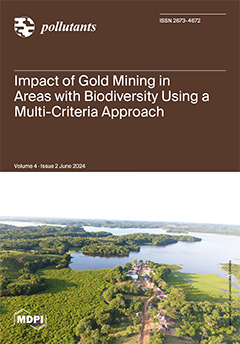Soil contamination by metallic components is an obscure, detrimental, protracted, and irreparable predicament. Dumping of waste containing heavy metals into landfills, fertilizer and pesticide application, and coal combustion results in high toxicity of metallic elements, and their continuous accumulation in soil pollutes the
[...] Read more.
Soil contamination by metallic components is an obscure, detrimental, protracted, and irreparable predicament. Dumping of waste containing heavy metals into landfills, fertilizer and pesticide application, and coal combustion results in high toxicity of metallic elements, and their continuous accumulation in soil pollutes the environment, which, in turn, poses a threat to human health. The specimens were subsequently dehydrated, processed for mineralization, and carefully examined microscopically by scanning electron microscopy and energy-dispersive X-ray spectroscopy (SEM/EDX), which examined their mineral substance, crystalline configuration, and chemical composition. Thirteen (13) elements were detected, and only eight (8) metals were discovered (K, Mg, Na, Ca, Al, Fe, Au, Ba), including non-metals (C, O, Cl, P) and a metalloid (Si). The concentrations of possibly toxic elements obtained showed no consistent succession, as they fluctuated across the examined sites. The Al concentration ranged from 3.78 ± 0.23 wt% to 10.23 ± 0.31 wt%, while the Fe concentration fluctuated from 4.14 ± 0.40 wt% to 13.13 ± 1.07 wt%. Na and Mg levels were present in all samples, but their availability was minimal, at less than 2.0 wt%, ranging between 1.44 ± 0.20 wt% and 0.31 ± 0.08 wt%. The concentrations of Ca and K were low in all soil samples, ranging from 0.91 ± 0.14 wt% to 5.56 ± 0.47 wt% for Ca and from 1.32 ± 0.25 wt% to 4.87 ± 0.18 wt% for K. During the investigation at the designated and control areas, it was discovered that the concentrations of potentially hazardous metals exceeded the accepted limits established by the World Health Organization (WHO) > 100 ppm. The findings provide proof of metallic contaminants in the study region, which calls for proper monitoring, management, and remedial measures of metal-tainted sites, since the residents of this locality are at a significantly elevated risk of experiencing adverse effects due to their heightened exposure to these elements. As a result of that, there is an imperative need to monitor and regulate this area regularly and appropriately. The study recommends sustainable farming practices, where farmers could use natural fertilizers and compost, as well as, the implementation of proper waste management, effective recycling techniques, and proper disposal of substances containing heavy metals as byproducts. Further implement remediation techniques that effectively and safely restore soils contaminated by metals in an environmentally sustainable and economically efficient manner.
Full article





